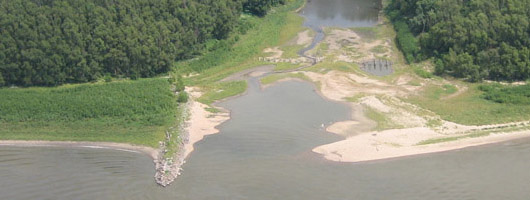
Boston Bar
Side channels are a critical biological component of the Mississippi River. Most side channels within the Middle Mississippi River (MMR) lack bathymetric diversity. They contain relatively few scour holes and had uniform bed response at high elevation. Boston Chute, located along the left descending bank (LDB) of the Mississippi River between River Miles (RM) 10.2 and RM 7.6, experienced similar problems. The chute is very shallow and connected to the Mississippi River only during high flows. Sedimentation is a problem in Boston Chute mainly due to closure structures and the back flooding of the Ohio River. There is a critical need to rehabilitate and conserve these critical aquatic habitats.
The purpose of this study was to address the need for additional biologic habitat inside Boston Chute as well as adjacent to Boston Bar, and communicate the results of the analysis of various river engineering measures.
The goals of the study were to:
- Investigate and provide analysis on the existing flow mechanics of the Mississippi River near Boston Bar.
- Calibrate a Hydraulic Sediment Response (HSR) model to replicate prototype bathymetry and velocity distribution of the Mississippi River near Boston Bar.
- Evaluate a variety of remedial measures utilizing the HSR model with the objective of identifying the most effective and economical plan to enhance biologic diversity within Boston Chute as well as adjacent to Boston Bar.
- Communicate to environmental agencies, other Corps personnel, and river industry personnel the results of the HSR model tests and the plans for improvements
Download

- Boston Bar Fly Through
- The purpose of this study is restore the side channel by reducing the amount of bed load entering the chute and increasing the amount of flow. Also material resulting from dredging...
